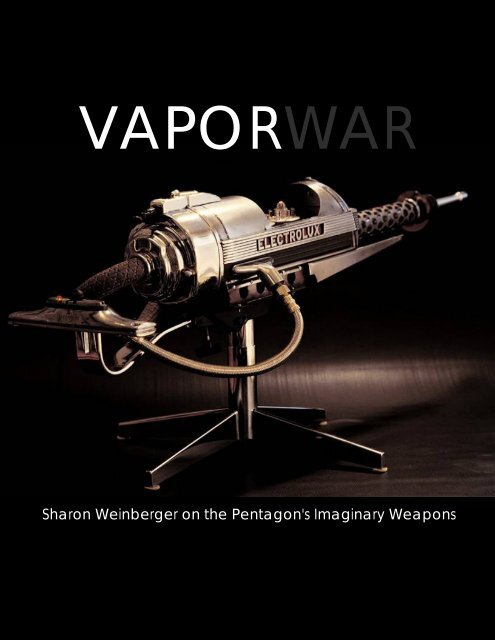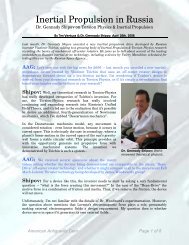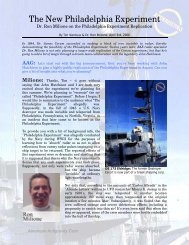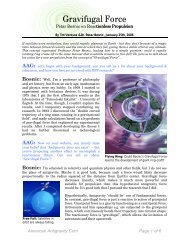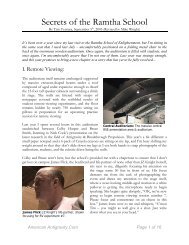Sharon-Weinberger-In.. - American Antigravity
Sharon-Weinberger-In.. - American Antigravity
Sharon-Weinberger-In.. - American Antigravity
You also want an ePaper? Increase the reach of your titles
YUMPU automatically turns print PDFs into web optimized ePapers that Google loves.
VAPORWAR<br />
<strong>Sharon</strong> <strong>Weinberger</strong> on the Pentagon's Imaginary Weapons<br />
Dream Come True: True <strong>Antigravity</strong> through the Veneficus<br />
<strong>American</strong> <strong>Antigravity</strong>.Com Page 1 of 11
VAPORWAR<br />
<strong>Sharon</strong> <strong>Weinberger</strong> on the Pentagon's Imaginary Weapons<br />
By Tim Ventura and <strong>Sharon</strong> <strong>Weinberger</strong>, June 19th, 2006<br />
It's called a “hafnium bomb”, and it uses a new type of stimulated nuclear isomer technology so deadly<br />
that the Pentagon doesn't want you to even know that it exists -- and according to <strong>Sharon</strong> <strong>Weinberger</strong>,<br />
it doesn't. We join the intrepid editor of Aviation Week's Defense Technology <strong>In</strong>ternational as she takes<br />
us on a journey through the Pentagon's scientific underworld...<br />
AAG: Let's start out with a bit of background information: you're an experienced defenseindustry<br />
reporter and editor with lots of experience covering the latest trends in military<br />
technology. However, it appears that your new book, "Imaginary Weapons", goes in a radically<br />
new direction with a focus on overhyped vaporware defense technologies. I'm wondering if you<br />
could start us out with a bit about your personal background, and what really inspired you to<br />
begin writing this book?<br />
<strong>Weinberger</strong>: I have some background in<br />
national security studies, but I really stumbled into<br />
defense reporting when I moved to Washington<br />
after graduate school. I was looking, like all<br />
newcomers to DC, to find work that didn’t involve<br />
toting someone else’s briefcase. I eventually ended<br />
up working for a small Beltway company doing<br />
research and analysis for the Pentagon. I worked<br />
with some incredibly intelligent and thoughtful<br />
people, and went from there into defense<br />
journalism.<br />
One of the things I learned from that experience is<br />
that the defense industry is itself an “underworld”<br />
in many ways, and I try to give readers a feel for<br />
this is my book. I remember sitting in the office of<br />
the head of the defense company I was working<br />
at—the CEO started talking about the fallout<br />
shelter in his backyard, and lecturing me on how<br />
much dirt you need over your fallout shelter to<br />
protect against radiation, and what wind patterns<br />
mean for radioactive fallout. I suddenly realized<br />
how absolutely weird the conversation was, and yet<br />
not so weird for those in the defense industry. We<br />
were discussing fallout shelters the way other<br />
people discuss barbeques. When you reside in an<br />
“underworld,” it seems so normal, but if you step<br />
back and look at it as an outsider, then you’re<br />
struck by how perverse it all is.<br />
Imaginary Weapons: A journey through<br />
the Pentagon’s scientific underworld.<br />
<strong>American</strong> <strong>Antigravity</strong>.Com Page 2 of 11
It’s not the vaporware per se that makes this an underworld, but the very odd culture of<br />
technology and national security. I don’t draw a line between the perverse and the normal<br />
cultures of defense technology—the two are intertwined because we are all so insulated from the<br />
outside world. I was inspired to try to describe this underworld—and my experience being in it—<br />
to others.<br />
AAG: My understanding is that while you examine several technologies in "Imaginary<br />
Weapons", the core story really involves something called hafnium-bomb, which you first heard<br />
about in a defense-briefing on Capitol Hill in 1998. Can you give us a bit of detail about the<br />
scope of technologies that you focus on in the book, and what it was about the hafnium bomb in<br />
particular that made it so central to this story?<br />
<strong>Weinberger</strong>: The book talks about some of<br />
the more controversial areas of science that have<br />
attracted military interest, including remote<br />
viewing (psychics), cold fusion and antimatter<br />
weapons. I do not list these areas with the idea of<br />
lumping them together as bad science, but rather,<br />
to point out how each of these subjects tends to<br />
attract support from the underworld.<br />
At one point, I considered writing this book as a<br />
collection of stories about the scientific<br />
underworld, but the feedback I got was: “You need<br />
a narrative to carry the reader long.” <strong>In</strong> that sense,<br />
the hafnium bomb is a trope for a larger story I was<br />
trying to tell about technology and national<br />
security.<br />
AAG: Speaking of the hafnium-bomb, I thought<br />
the idea sounded reasonable until I saw your<br />
website, which featured a "hafnium grenade"<br />
claimed to deliver a 2-kiloton yield. Now from a<br />
layman's perspective, my first thought is that a<br />
nuclear hand-grenade has some immediately<br />
obvious drawbacks to deployment, so how’d this<br />
one make it that far up the chain of command?<br />
Hafnium Grenade: A hand-grenade<br />
claiming to deliver a 2-kiloton nuclear blast?<br />
<strong>Weinberger</strong>: Lots of ideas sound reasonable until you look at the practical implications.<br />
To be fair, the Defense Advanced Research Projects Agency (DARPA), in its official briefings to<br />
Congress about hafnium, described the power of a 2,000 pound bomb in the package of a 50<br />
pound bomb. But even that is impractical, and, according to the experts, simply not feasible.<br />
AAG: Now to turn the question around a bit, I've heard rumors that Los Alamos has been<br />
playing with laser-triggered nuclear isomers for years: at least in the context of a quasi-stable<br />
fuel-pellet for use in nuclear space propulsion. Is it possible that this particular idea made it past<br />
the screeners because of simple name-recognition and maybe just a lack of close-scrutiny on the<br />
proposed implementation, or is the entire nuclear-isomer thing just a fish-story?<br />
<strong>Weinberger</strong>: Yes, Los Alamos has been a “hot bed” for nuclear isomer enthusiasts,<br />
although some of them may have retired by now. But it’s important to differentiate between<br />
<strong>American</strong> <strong>Antigravity</strong>.Com Page 3 of 11
interest in nuclear isomers, and the specific 1998 results that sparked the debate over the<br />
“hafnium bomb.” What is primarily at issue in my book is an experiment conducted in 1998 that<br />
led a scientist in Texas to claim he had “triggered” the hafnium isomer (hafnium-178m2) using<br />
photons from a dental X-ray machine. Those results could not be reproduced by independent<br />
researchers, and the initial claims violated some laws of physics. However, this does not cover<br />
the entire range of isomer physics, just the specific idea of a nuclear hand grenade based on the<br />
hafnium isomer.<br />
AAG: <strong>In</strong> "The Social Life of <strong>In</strong>formation", Brown & Duguid made an excellent point that<br />
technology stories like the hafnium-bomb or even the Philadelphia Experiment are part of an<br />
oral-tradition that's an ingrained part of the engineering & defense culture. They believe that<br />
stories like this stick around because they contain inherent information value, but that like any<br />
metaphorical tale, the information is often seriously diluted & misinterpreted over time. Any<br />
thoughts on how this might affect these "cutting-edge" technologies as they filter up from the<br />
engineering to the administrative levels in industry & government?<br />
<strong>Weinberger</strong>: I love that idea, truly. Oral<br />
traditions are a wonderful thing, and you may well<br />
be right about how those work. <strong>In</strong> a sense, the<br />
isomer bomb has been one of those stories: every<br />
few years nuclear weapons scientists would say,<br />
“Hey, wouldn’t isomers make for a great bomb?”<br />
Then the scientists would discuss it, realize the<br />
limitations, and (usually) move on.<br />
But the hafnium bomb should not be equated with<br />
all isomer research. That would be unfortunate.<br />
The idea is not to discourage truly forward thinking<br />
ideas, but to ensure that the ideas we do fund are<br />
grounded in reality (and science). I do hope the<br />
hafnium bomb becomes a reminder of why you<br />
don’t want to go off the deep end.<br />
Carl Collins: The hafnium researcher in his<br />
laboratory at the University of Texas.<br />
AAG: I'd like to broaden our scope just a bit from the book itself to some examples<br />
throughout the defense-industry. First, I'd like to touch on what I call "me too" technologies,<br />
which I guess would include Darpa's massive push towards <strong>In</strong>formation Technology solutions<br />
for any and every problem they come up against. They invented the internet, and IT certainly<br />
offers flashy solutions, but do you think that they're over-investing in IT simply because it gets<br />
them publicity to push initiatives in this area?<br />
<strong>Weinberger</strong>: Every DARPA director wants a legacy. I’ve heard, very second-hand, that<br />
the current director wants it to be cognitive computing, and DARPA has put a lot of investment<br />
into that area. At the same time, the New York Times ran an article some time back on DARPA’s<br />
cutbacks on university funding for IT. I can’t say which areas are over or under-invested in---I<br />
simply haven’t looked at the budget in that sort of detail. Though I’m sometimes critical of<br />
DARPA, I think its portfolio is likely balanced to reflect the current exigencies of war, and that<br />
may be quite reasonable.<br />
AAG: Speaking of which, the mother of all over-hyped "me too" technologies these days is<br />
nanotechnology. I probably don't even need to list examples (MIT's nanotech armor), but I<br />
should point out that the fundamental basis for Drexlerian nanotechnology - the nanoassembler<br />
- is still decades away from being a reality. Is nanotech a defense-industry example<br />
<strong>American</strong> <strong>Antigravity</strong>.Com Page 4 of 11
where they're pushing a dream towards reality, or is this a case where the people following this<br />
craze are driving everybody else over the edge of a cliff with unrealistic expectations?<br />
<strong>Weinberger</strong>: I want to be careful here, because again I haven’t examined the<br />
nanotechnology issue much, particularly as it pertains to defense. If I were to learn that it’s<br />
being overhyped in defense, that wouldn’t surprise me, because there’s a tendency to do that.<br />
Certainly defense companies still regard nanotech as very basic research---something to be left<br />
to the universities, and I don’t know how much<br />
Defense Department funding is going to<br />
nanotechnology at the moment.<br />
<strong>In</strong> a somewhat related area, I recently saw that<br />
some researchers in meta-materials (negative index<br />
of refraction) are touting the research as a possible<br />
application to stealth. Metamaterials started off a<br />
few years ago as a somewhat controversial area, but<br />
seem now to have moved solidly into advancing<br />
science with possible applications. But I can’t help<br />
but wonder if it seems to be a tad reaching (toward<br />
the arms of funding agencies) to claim applications<br />
in stealth. But, who knows?<br />
AAG: One area that I'd like to ask about is the<br />
difference between broad cross-organizational<br />
initiatives, such as the pressing need to eliminate<br />
IED's in Iraq, and the many "pet projects" that<br />
seem to fly under the radar. Can you comment at<br />
all on pet-projects in general, and whether they're<br />
more susceptible to going completely off-track into<br />
areas like the hafnium technology -- maybe as a<br />
result of insular development cultures or a lack of<br />
proper oversight?<br />
Defense Tech <strong>In</strong>ternational: Sept/Oct<br />
2005 issue, edited by <strong>Sharon</strong> <strong>Weinberger</strong>.<br />
<strong>Weinberger</strong>: I think the insular culture (or what I refer to as an underworld) can be a<br />
part of the problem with things going off track with some of the more wild ideas, but it’s not the<br />
only issue to consider. If you get a defense official who is dead set on an idea—to the exclusion of<br />
outside review, you can do some serious damage. I think that’s what happened with the hafnium<br />
bomb to a large degree. Is this a universal problem? I think the issue of “vested interests” of<br />
program officers in defense projects is a problem, but one that extends far beyond “fringe<br />
science” and into the mainstream defense establishment. There’s also a larger issue here: the<br />
general scientific decline that many are observing within our defense establishment.<br />
The IED issue is very different. There, we are trying to tap science and technology to find<br />
immediate solutions to a problem that may defy any technical panacea. It’s a tragedy—the most<br />
technologically advanced military in the world is being done incredible harm by the most<br />
rudimentary of weapons.<br />
AAG: Now organizationally, what role does the Bush (or any) administration play in these<br />
technologies - or are they below the level of the administration's awareness?<br />
<strong>American</strong> <strong>Antigravity</strong>.Com Page 5 of 11
<strong>Weinberger</strong>: I think most of them are below the administration’s radar screen, and that<br />
perhaps is part of the problem. Top officials are focused on Iraq. So, it’s more a problem of<br />
neglect.<br />
AAG: What role does general fear, uncertainty, and doubt (FUD) about enemy capabilities<br />
play in pushing through otherwise untenable technologies? I mean, it seems like some of these<br />
initiatives are really sold on the idea that "somebody might beat us to it", which seems to play<br />
into a culture of generalized anxiety in the defense industry. Any thoughts on this?<br />
<strong>Weinberger</strong>: That’s a huge, huge driving<br />
factor in a lot of what the Pentagon does. Just<br />
about every defense technology official you’ll meet<br />
will say, “My job is to prevent technological<br />
surprise.” And then they’ll talk about Sputnik,<br />
Japanese torpedoes, Soviet subs, etc. All those<br />
things that “surprised us” in one way or another.<br />
But when you look at the things that surprised us,<br />
you have to think about why they surprised us. It<br />
wasn’t typically things that we thought violated the<br />
laws of physics, but rather technological advances<br />
that competitors had made and where our<br />
intelligence wasn’t very good. So, when we speak<br />
about the hafnium bomb and competitors, we have<br />
to ask: is this an intelligence problem or a physics<br />
problem?<br />
AAG: Speaking of FUD, I've heard rumblings<br />
about China being the next "Soviet Union", and I'm<br />
wondering if you have any thoughts on this aspect<br />
of military programs driving foreign policy? Could<br />
there be a "trickle-up" effect from the defenseindustry<br />
to the administration pushing this anxiety<br />
into the foreign policy area?<br />
DTI 2006: A focus on radar coverage in<br />
Jan/Feb 2006, a bimonthly AvWeek feature.<br />
<strong>Weinberger</strong>: Organizations operate like human beings—they want to grow, become<br />
richer, and live forever. The China threat might indeed be real, but certainly I see a tendency to<br />
hype their capabilities in specific areas as a convenient way to garner support for favored U.S.<br />
defense projects. But is the tail wagging the dog, as your question suggests? That I’m not so sure.<br />
Rather, I think those with interests in these technologies are simply happy to play upon an<br />
existing belief within the current administration.<br />
Just for the record, I think the notion of a “military-industry complex” is misunderstood. This<br />
idea presumes much more power than these industries have. The influence is less at the<br />
strategic level and more at what I call the tactical level (i.e. the revolving door of defense officials<br />
who move into private employment and vice versa).<br />
AAG: Do you think that our military intentionally inflates their claims about enemy<br />
capabilities to sustain their budgets? I think that the difference between the cold-war picture of<br />
the Soviet Union and the reality of their defense-capabilities was shocking to most people, and<br />
I'm wondering if this might have been intentional, or just a runaway side-effect of selfreinforcing<br />
perceptions about the unknown?<br />
<strong>American</strong> <strong>Antigravity</strong>.Com Page 6 of 11
<strong>Weinberger</strong>: I’m not sure intentional is the right word. It’s very easy to make yourself<br />
believe in something you want to believe in. It’s certainly advantageous for some military<br />
officials to promote and hype particular foreign threats in the hopes of furthering their own pet<br />
projects. Yes, there were certainly some egregious examples of this during the Cold War, like the<br />
so-called missile gap, and the imaginary Soviet nuclear bomber. We must be vigilant and<br />
cautious of such claims.<br />
AAG: Now you've said that the hafnium-bomb wasn't supported by scientific evidence, and<br />
I'd like to use that to touch on the idea of subjectivism & politics in scientific review. <strong>In</strong> a<br />
political environment, when funding is at stake, how should the military involve scientific review<br />
for various ideas -- especially when the supposedly impartial scientific review panels seem to be<br />
so politically driven themselves?<br />
<strong>Weinberger</strong>: There is no perfect model, and peer review doesn’t work for everything.<br />
Jimmy Wales, the founder of Wikipedia, gave a really eloquent interview some time back<br />
describing how he first tried a model for Wikipedia<br />
using peer review by experts, and it failed dismally.<br />
Now look at the success of Wikipedia, with no<br />
experts and no peer review, but rather, a<br />
community of users who constantly improve upon<br />
the entries. I think it would be beautiful if somehow<br />
science evolved to this sort of “community of users”<br />
model, I just don’t know how it would be done.<br />
High-level physics is just not accessible to the<br />
masses (let alone the experimental equipment<br />
needed for, let’s say, high energy physics). [Just<br />
after writing this answer, I also note a New York<br />
Times article on how Wikipedia will start<br />
restricting edits of some entries—so that model<br />
isn’t perfect either.]<br />
Certainly the <strong>In</strong>ternet is helping us move to an<br />
open model for science in some areas, by allowing<br />
scientists in frontier (or “fringe”) science to publish<br />
on the web without the need for peer review. <strong>In</strong><br />
another arena, such as mass media, anyone now<br />
can create a blog, or a news site. The access to entry<br />
is low, and so it opens up the field. Some people in<br />
the media view this as a threat, but I think it’s just<br />
wonderful.<br />
Cutting Edge: DTI explores military robotics<br />
in its March/April 2006 special edition.<br />
Now, when it comes to funding of science, that’s another story. I just don’t know if there is a<br />
better model than peer review. It’s possible that peer review can promote group think, or that<br />
good ideas are quashed because they are competitive with those of the reviewers. There are<br />
elements of truth in these claims, I’m sure. But what’s the alternative?<br />
I think there could be a better model for government funding of truly far-reaching science. One<br />
method may be the old Advanced Energy Projects division of the Department of Energy. That<br />
office funded a lot of high-risk research using peer review at particular points to determine if a<br />
project could go forward, but it allowed some discretion by the director. That office is now gone,<br />
but I think reestablishing something along those lines makes a lot of sense, particularly with the<br />
<strong>American</strong> <strong>Antigravity</strong>.Com Page 7 of 11
current concerns about energy. And, of course, wouldn’t we all love to have the old industrial<br />
labs, like GE? But that, I’m afraid, is a thing of the past.<br />
AAG: Another issue is the pervasive problem of "quick-fix" thinking: pushing marginally<br />
useful or generally inelegant solutions as short-term solutions that fail to address long-term<br />
problems? Maybe this comes out of corporate America's narrow-focus on quarterly-profits, but<br />
I'm wondering if the problem of fixing the symptoms rather than the cause isn't a real issue in<br />
terms of the defense industry as well?<br />
<strong>Weinberger</strong>: I don’t want to over-generalize, but I think we see this problem in how the<br />
Pentagon is addressing the threat of improvised explosive devices. Understandably, they want<br />
quick fixes, because it’s an immediate problem. But they also need to be funding basic science<br />
and technology in the hopes that we can come across breakthrough technologies that would help<br />
with this problem.<br />
AAG: Is there a point where our technological<br />
edge in a specific area becomes apparent enough<br />
that we should stop investing money in an already<br />
mature technology? For instance, if we can hit a<br />
thumbtack with a guided missile launched from an<br />
aircraft 5 miles away, is it worth spending millions<br />
a year to continue enhancing the technology?<br />
<strong>Weinberger</strong>: If money were free, I’d say,<br />
heck, let’s invest in all of it. Personally, I’d like to<br />
study why salt shakers can stand on their edge in a<br />
pile of salt—pondering this oddity has kept me<br />
awake through many a corporate dinner. Seriously,<br />
though, in a world of choices we must prioritize.<br />
However, in the case of maturing technology, I<br />
actually do believe in upgrades. After all, part of<br />
“technological surprise” can be when our<br />
competitors make advances in existing technology<br />
that we didn’t expect. So, it depends on the<br />
circumstance. I am more critical of the massive<br />
expenditures in something like, say, a new fighter<br />
aircraft, if we see that the superiority, relative to the<br />
financial costs, may not be warranted.<br />
DTI Goes To Sea: A focus on emerging<br />
naval stealth in the Nov/Dec 2005 issue.<br />
AAG: <strong>In</strong> a case like that, wouldn't it be better to push an initiative to reduce the cost of these<br />
mature technologies rather than enhance their effectiveness to the point of absurdity?<br />
<strong>Weinberger</strong>: I might actually disagree here slightly with this premise. Effectiveness is<br />
important---if you’re going to spend billions of dollars to deploy a missile defense system, then I<br />
would much rather that it is 95 percent effective than 75 percent effective. The question is<br />
whether we really need the capability in the first place, relative to the base investment. As I said<br />
in the question above, we need to be critical about the initial investments in expensive<br />
technology.<br />
AAG: Would vaporware weapons-projects have any tertiary value in terms of psychological<br />
warfare? Personally, I've always wondered if maybe some of the government non-answers about<br />
<strong>American</strong> <strong>Antigravity</strong>.Com Page 8 of 11
UFO's might not be an intentional way of keeping the enemy guessing about exactly what kinds<br />
of uber-weapons we have hidden away in our arsenal.<br />
<strong>Weinberger</strong>: Never assume conspiracy when incompetence will suffice as an<br />
explanation. I think the government simply never figured out quite how to deal with all the UFO<br />
memos in its archives. Some people were worried about embarrassment, perhaps, and maybe<br />
some people were really worried about UFOs (possibly). People assume the government<br />
operates with one voice---it doesn’t. As for psychological warfare, I’m not sure government is<br />
that savvy.<br />
Let’s take another example. New Scientist recently reviewed my book, and although the review<br />
was really quite positive and thoughtful, the author ended by asserting that perhaps the hafnium<br />
bomb was an intentional effort to dupe our enemies into thinking we had a fantastic new<br />
weapon. Wow, what a marvelous thought. But I have to ask: On what does the reviewer base this<br />
assertion? As a journalist, I have looked at the documentation and evidence, and there is<br />
absolutely nothing that would lead me to support such a contention, so why should I write it? If<br />
indeed the purpose of investment in the hafnium bomb were to fool others into thinking we<br />
were on our way to a new fantastic arms race, then only Popular Mechanics and a handful of<br />
other publications were duped. The Russians, on the other hand, were making fun of the<br />
hafnium bomb almost from the start.<br />
Journalism, particularly as it pertains to national<br />
security, has a moral obligation to be responsible,<br />
and not to perpetuate fantasy, or a political agenda.<br />
I truly believe this.<br />
AAG: What happens to these programs after<br />
they disappear? Does the technology get<br />
reabsorbed into other projects, or do they literally<br />
crate up the research and stick in next to the Ark of<br />
the Covenant in that big warehouse at the end of<br />
<strong>In</strong>diana Jones?<br />
<strong>Weinberger</strong>: I like the Ark of the Covenant<br />
idea. I like to say that no bad idea ever dies at the<br />
Pentagon, it just ends up in another agency. These<br />
proposals lie dormant, and then are rediscovered<br />
and repackaged. I guess this is inevitable to some<br />
degree. I have no doubt that hafnium will rise like a<br />
phoenix from the ashes at some point—but when it<br />
does, I hope people say, “Remember the dental X-<br />
ray and the nuclear hand grenade?”<br />
Oil Crunch: DTI tackes military fuel supply<br />
logistics in it’s latest May/June 2006 issue.<br />
AAG: Do you think that the current SBIR<br />
process actually limits the development of new technologies? The reason I ask is that I've met<br />
many inventors with projects they'd love to get DoD financing for, but most of the time they end<br />
up getting pushed into trying to match their unique invention with an arcane list of "SBIR<br />
projects" (like stealth belt-buckles)?<br />
<strong>Weinberger</strong>: That’s funny—I love the idea of “stealth belt buckles.” You know, I think a<br />
study of the Small Business <strong>In</strong>novative Research (SBIR) process would be an excellent area for<br />
journalists to look into. Does it work? Could it work better? On one hand, you have an entire<br />
<strong>American</strong> <strong>Antigravity</strong>.Com Page 9 of 11
usiness sector that wouldn’t exist were it not for the SBIR process. On the other hand, as you<br />
point out, you have the stealth belt buckle issue.<br />
But you have to understand why that exists. If you’re not solving a problem the military needs,<br />
what good are you doing, and who will buy your fabulous technology? On the other hand, I<br />
suppose if you want true innovation, you don’t want to overly limit proposals. Maybe the<br />
solution is to strike a balance between the two: practical problems and far-reaching ideas.<br />
AAG: What about over-engineering: the best example is NASA designing the space-pen with<br />
a pressure-loaded cartridge to write upside down without running dry, while the Russians<br />
effectively solved the same issue by issuing their cosmonauts pencils. Does the incentive to drive<br />
large, financially-profitable defense-contracts lead us towards these Rube Goldberg style<br />
approaches to solve everyday challenges, and has this been addressed at all in the defenseindustry?<br />
<strong>Weinberger</strong>: That’s a good question, but I would reply with, “it depends.” When you’re<br />
dealing with multibillion dollar weapon systems, you sometimes can’t afford for little things to<br />
go wrong. On the other hand, you don’t want to create a billion dollar solution to something a<br />
stick of gum can fix.<br />
“We should never dismiss any idea out of hand as being fringe...<br />
We should challenge orthodoxy and encourage free thinking.”<br />
AAG: I'd like to focus on aerospace for just a second, because I've talked to Nick Cook over at<br />
Janes a few times about industry trends, and he's very concerned that aerospace is going<br />
through a period of profound decline right now. For instance, the average age of most aerospace<br />
engineers is 55 years old, because the industry only produces refinements on mature<br />
technologies, which means that young innovators go for the high-paychecks & creative<br />
fulfillment of the IT industry rather than aerospace. Can you give us your thoughts on this<br />
industry, and whether it's really in decline or not?<br />
<strong>Weinberger</strong>: Cook is very correct. My brother for example, studied aerospace<br />
engineering at Stanford about 10 years ago, and like most of his colleagues, went into computer<br />
programming. That’s where the excitement was—aerospace wasn’t a fun or creative field to be<br />
in. There’s going to be a big crisis as the current generation of aerospace engineers retires; I<br />
don’t think anyone knows what to do about it. There needs to be a lot more funding for basic<br />
research and development—that will help attract younger workers. But I don’t know if that’s<br />
politically feasible right now. Where will the money come from?<br />
How to fix it? I’m just not sure. Maybe we need simply to accept that IT, and not aerospace, is<br />
the growth field. My guess is that for the aerospace industry to be reinvigorated, we’ll need the<br />
next breakthrough in propulsion—that technology that really will effectively get us to Mars and<br />
beyond. So, there needs to a big push into R&D, but I don’t see that money coming down the<br />
pike.<br />
AAG: Well as a professional who works across a variety of defense-related industries, which<br />
ones would you say are really on the upswing right now? Can you give us an idea of what the<br />
players & technologies are that are going to really be making an impact in 21st century defense?<br />
<strong>American</strong> <strong>Antigravity</strong>.Com Page 10 of 11
<strong>Weinberger</strong>: I hate to make predictions; they are always wrong. I would say that<br />
directed energy is the “next big thing,” but then again, that’s been the next big thing for the past<br />
20 years. Who would have guessed that homemade bombs would be the big threat in the current<br />
war? Not me. I’m good with evidence, but bad with predictions. The future is unknown.<br />
AAG: Let's close on a personal note: can you tell us a bit about the projects that you're<br />
currently pursuing, and are you planning more books or perhaps public speaking engagements<br />
related to this one in the future?<br />
<strong>Weinberger</strong>: I’ll be doing a Q&A<br />
at Politics & Prose Bookstore on July 8,<br />
and another reading at the Strand in New<br />
York on July 10. Details of the events are<br />
available on the bookstores’ websites, and<br />
I welcome everyone to attend. Some of the<br />
subjects I deal with are controversial, and<br />
I know not everyone will agree with my<br />
views, so I invite debate.<br />
Right now, I’m in the middle of<br />
investigating another “fringe science” area<br />
the Pentagon has been involved in. I’d<br />
prefer not to discuss it too much right<br />
now, but it has important societal<br />
implications (particularly if it works).<br />
Pentagon City: What other breakthroughs can be<br />
found inside America’s most secure military facility?<br />
And that, by the way, is my final note: we should never, ever dismiss any idea out of hand as<br />
being fringe. Rather, we should investigate and study these ideas. We should challenge<br />
orthodoxy and encourage free thinking. But when all is said and done, we must make our<br />
judgments based on the evidence we have in hand, and we should expect the agencies<br />
responsible for national security to do the same. For me, that is the lesson of Iraq and WMD’s,<br />
as well as of the hafnium bomb…<br />
<strong>Sharon</strong> <strong>Weinberger</strong> is the editor-in-chief of Defense Technology <strong>In</strong>ternational, a bimonthly<br />
editorial supplement to Aviation Week & Space Technology. Her writing on science and<br />
technology has also appeared in Slate, and the Washington Post Magazine. For additional<br />
information on her latest projects, visit <strong>Sharon</strong>’s site online at Imaginary Weapons.com<br />
<strong>American</strong> <strong>Antigravity</strong>.Com Page 11 of 11


